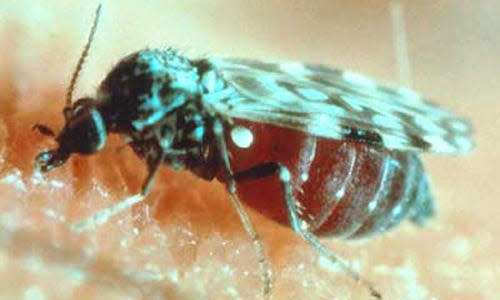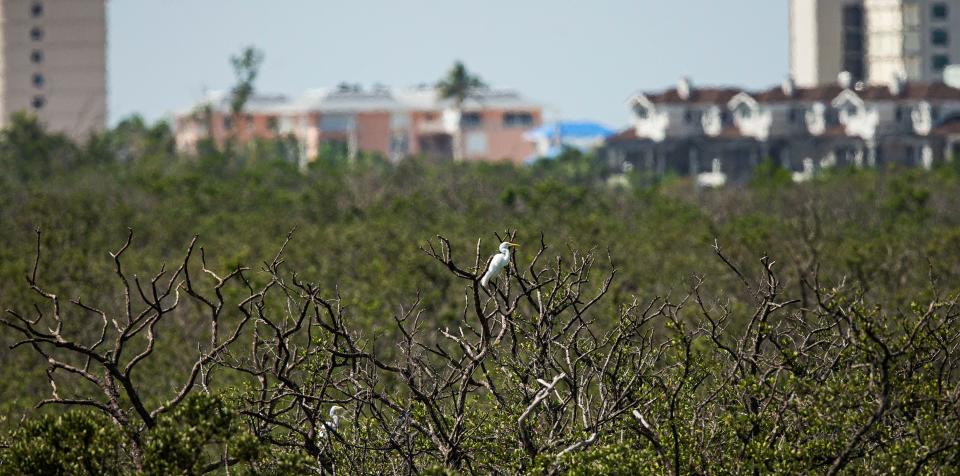Annoying, blood-sucking noseeums invading Southwest Florida: What we know

"The Invasion of the Noseeums." It sounds like a great summer movie title, but it is reality for coastal communities in Southwest Florida this year, from Sanibel Island to Marco Island.
Like so many other things right now, put part of the blame on Hurricane Ian and what it did when it came roaring through here on Sept. 28, 2022, said Stephen Brown, Horticulture Agent with the University of Florida/IFAS Lee County Extension.
Coastal areas provide primary habitat for noseeums.
"They (noseeums) inhabit salt water marshes and places like that," Brown said. "My guess is we had a lot of destruction of the mangroves on Sanibel and that area where mangroves were destroyed, surge water entered and made the marshes more salty. An accumulation of organic material is what they feed on. The dead mangroves may be more of an area that is more favorable to proliferation of midges."
Why so many noseeums? Noseeum defense: Some serious, not so serious solutions, to fend off this annoying bug
We applaud this: When it comes to ‘dirty jobs,’ this Fort Myers couple is all in, using their boat to snag trash
Noseeums are also known as biting midges.
Brown added that the Hurricane Ian impact is only part of the equation.
"It's also the weather," Brown said. "It's summer. There's the humidity. Because of the heat and the humidity you have fast decomposition."

One other factor Brown mentioned was the lack of a natural predator for the noseeums.
"What could have also happened, a lot of their natural predators could have taken a hit. Predators always lag behind coming back because they need a food source, and the source could be the midges," Brown said. "Hopefully, by next year more the noseeum population will be more controlled by natural predators, like small wasps."
So, are the noseeums worse this year compared to previous summers? There is no scientific evidence of it, but it you listen to the chatter on social media, it is next-level. Locals and visitors alike are almost posting daily in Facebook groups about how bad this summer has been, especially on Sanibel.
Noseeum isn't a four-letter word, but it might was well be.
Holly Millbrandt, the director of natural resources for the City of Sanibel, agreed the noseeums have been particularly bothersome.
"My perception is they have been bad since the storm," Millbrandt said. "Not sure if they are consistently worse compared to other years. It's hard to say, whether it's people doing more work outside undertaking hurricane restoration activities."
There is no spraying for noseeums on Sanibel. People have to figure out what is the best defense for them, whether it is a commercial bug spray like OFF with Deet, or a homemade concoction, which plenty of people are posting on social media these days.
Shell tales: 6 Florida shellers share 'spectacular' find stories to celebrate National Seashell Day
What does Millbrandt use to fend off the annoying little bugs?
"Long sleeves and long pants. That's my personal philosophy," Millbrandt said. "That is normal field attire. My family has been visiting for years and we have tried all of the things from baby oil to Skin Soft."
Millbrandt has witnessed more creative approaches. She was recently in the field, near Lighthouse Beach and saw something that made her laugh.
"It was in the morning − noseeums are worse at dawn and dusk. There were some younger gentleman there on the beach and they swatting everyrhing they could." Millbrandt said. "Finally one said, 'I am running into the water.' "
Those of us living or visiting here just need to be resilient, right?
"They (noseeums) are also resilient," Millbrandt said.
Noseeums: Five things to know
According to a University of Florida/IFAS fact sheet:
No-see-ums live in Florida's warmest months, which are June and July. Adults are most active at dusk and dawn and congregate near standing pools of water. During this time, female no-see-ums lay upwards of 400 eggs in a batch, hatching after two to seven days.
A common observation upon experiencing a bite from this insect is that something is biting, but the person suffering cannot see what it is.
Biting midges are sometimes incorrectly referred to as sand flies. Sand flies are insects that belong to a different biological group and should not be confused with the biting midges.
There are over 4,000 species of biting midges in the Ceratopogonidae family. 47 species are known to occur in Florida.
Areas with substantial salt marsh habitat are major producers of many biting midge species.
This article originally appeared on Fort Myers News-Press: Noseeum population on Sanibel, beaches thriving after Hurricane Ian

